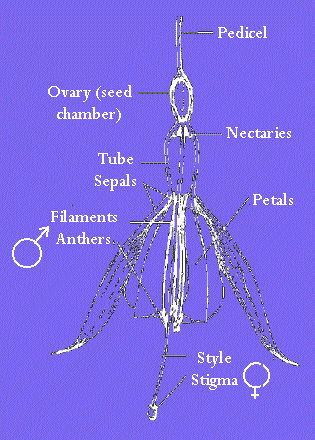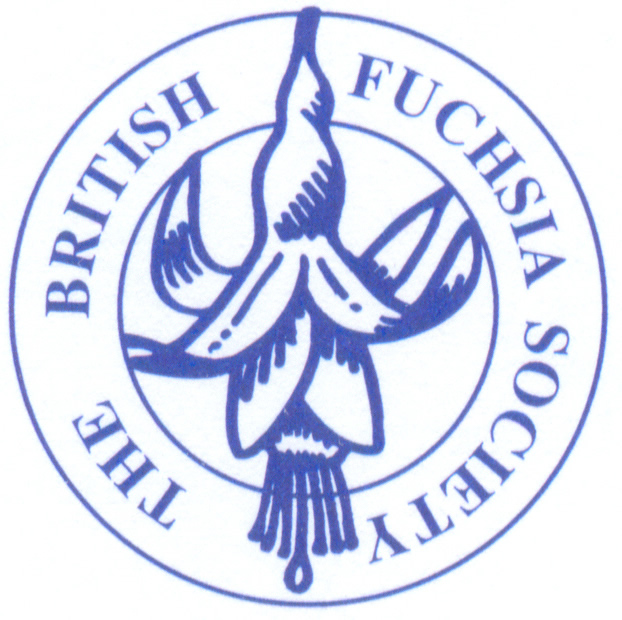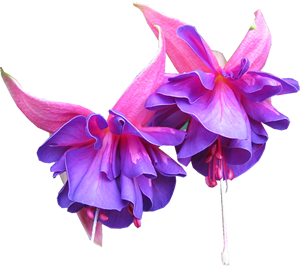
Georgeous Gemma
I started to get interested in hybridizing fuchsia's about 12 years ago. Since then I have released and registered with the American fuchsia Society over fifty cultivars, named mainly after members of my family, but two were named after deceased persons. One was named after a friend of my daughter who was killed in a car accident and the other was named after a late Colchester man, HARRY MOSS, when his sister won it in a raffle "Name your own Fuchsia" which I organised to raise money for a local hospital Special Baby Care Unit. More recent releases have been named after members of the society, or their family, in recognition of the help they have given. I try to give the cultivars a name that will be universally popular to many people. For example by naming my grand-daughters cultivar "NAUGHTY NICOLE" anyone who has a family member called Nicole is more likely to buy it than if it had been called Nicole Farrell. The same is true of all of the cultivars I release.
The following description is only intended as a guide. Genetics and "Mendels Law" all come into hybridizing but I do not profess to understand it fully myself. I try to use cultivars that are attractive, show disease resistance and that are floriferous. I also look at the growth habit, shape of the bloom, colour and foliage. I do about two to three hundred cross pollinations most years and out of this I usually get about one third which will produce seed, resulting in between 300 to 500 seedlings. Of this I probably keep about 10 which will be grown and tested over the next three or four years, sometimes longer. I like what I produce but without having seen the 10,000 or more cultivars that are available it is impossible to tell if they are completely different to any that are on the market. I take them to specialist fuchsia nurseries, show them at societies and ask for comments from other fuchsia hybridizers. They are also tested and evaluated at nurseries. If they consider them to be worth releasing then I do so.

Beautiful Bobbie

Grandma Flo
Choose a flower which you wish to pollinate. Pick a flower which is at the top of the plant and about to open. Open the bloom with tweezers or a small pair of scissors being careful not to damage the STYLE or STIGMA. Remove the FILAMENTS and ANTHERS from the bloom, again being careful not to damage the STYLE and STIGMA. This is now known as the SEED PARENT. This process is known as EMASCULATION. Having already chosen a plant that you wish to use as the pollinator make sure that the pollen is fresh. The pollen may be attached to viscine threads (appears sticky) or may be small grains of dust that are hardly visible. Various factors of heat, wind and humidity can affect the pollen. You can also have sterile plants and infertile pollen. It is believed by certain experts that 8am to 10am is the optimum time to carry out these cross pollinations. The plant from which the pollen is obtained is now known as the POLLEN PARENT. You need to carefully collect the pollen from the ANTHERS of the POLLEN PARENT either by removing the ANTHERS or the complete flower and transfer the pollen to the STIGMA of the SEED PARENT. Some people use small paint brushes, others their fingers.
There are various schools of thought about what should happen now. Some people believe that the STYLE and STIGMA should be covered to stop further pollinations by insects or wind. Others believe that the pollination, if successful, is like human fertilization and that once the pollen has taken the door is shut to further pollen grains. I believe the latter to be true. For various reasons not all pollinations will take, or seed set. You may have one seed, 30 or more or none at all, even in a seed pod that seems apparently ripe.
You will now need to keep records of the SEED PARENT and POLLEN PARENT for every cross that you make, plus ensuring you keep a label in the pot. You should also put either a long thin computer label or coloured twist tie carefully around the PEDICEL to denote which flower you have pollinated. I prefer to use the coloured twist ties, giving each cross of the SEED PARENT a different colour. If and when the seed pod (OVARY) swells and ripens you should remove it and place it on some paper, such as kitchen roll or newspaper. With white paper you are more able to see the seeds. Using a sharp blade such as a scalpel open the seed pod to see if seeds are present. They are usually small, brown, and quite hard, although they may be larger and lighter in colour. Even if the seed appears to be immature it still may germinate. If there does not appear to be any seed present check the area where the PEDICEL joins the seed pod (OVARY). Sometimes a single seed may be found. Carefully remove the seeds to small trays or pots, ensuring that you label them again with details of the SEED PARENT and POLLEN PARENT. Push the seeds into moist compost but do not cover the seeds. It also helps to put the seeds near to the edge of the pot and to cover with a clear plastic cup to maintain the humidity. The ideal temperature is around 64 degrees F. Germination times vary.

Naughty Nicole

Grandpa Jack
When the seeds germinate and are large enough transplant to individual pots and label each one correctly. There are various methods people use, but I prefer to label them as follows: :-
---------------------------------------------
Seed Parent *1 (colour of t/tie)
(X Pollen Parent) Date
---------------------------------------------
I also keep a record of the time, cross and location of the plant in a small notebook. Any additional seeds from that cross would therefore be numbered *2 and so on. This needs to be done for every cross pollination that you do. When the seedlings are large enough take cuttings, again making sure that you label them correctly. The cuttings will grow quicker and stronger than the original seedling. Providing you have been successful with the above you will need to grow and test the plant/plants for at least three years and to start showing to people to get their opinions. If a nursery likes it you can then release it, and if you wish, register it with the American Fuchsia Society.
Alternatively you could grow it for your own use, after all it is your plant, and whatever other people think you will love it!
Have a try - and good luck.

Picture courtesy of Edwin Goulding

Loveable Rascal






